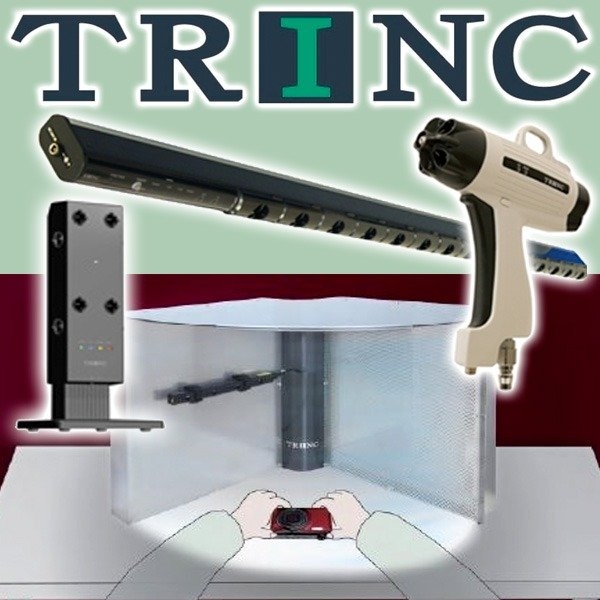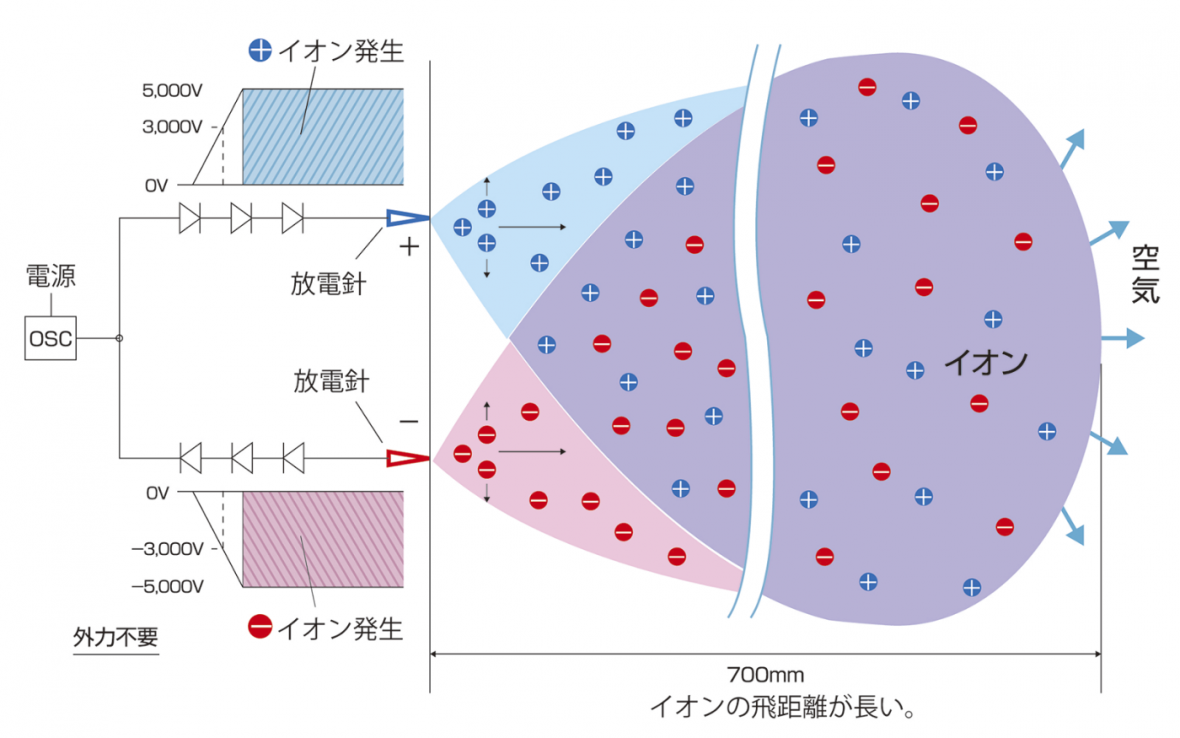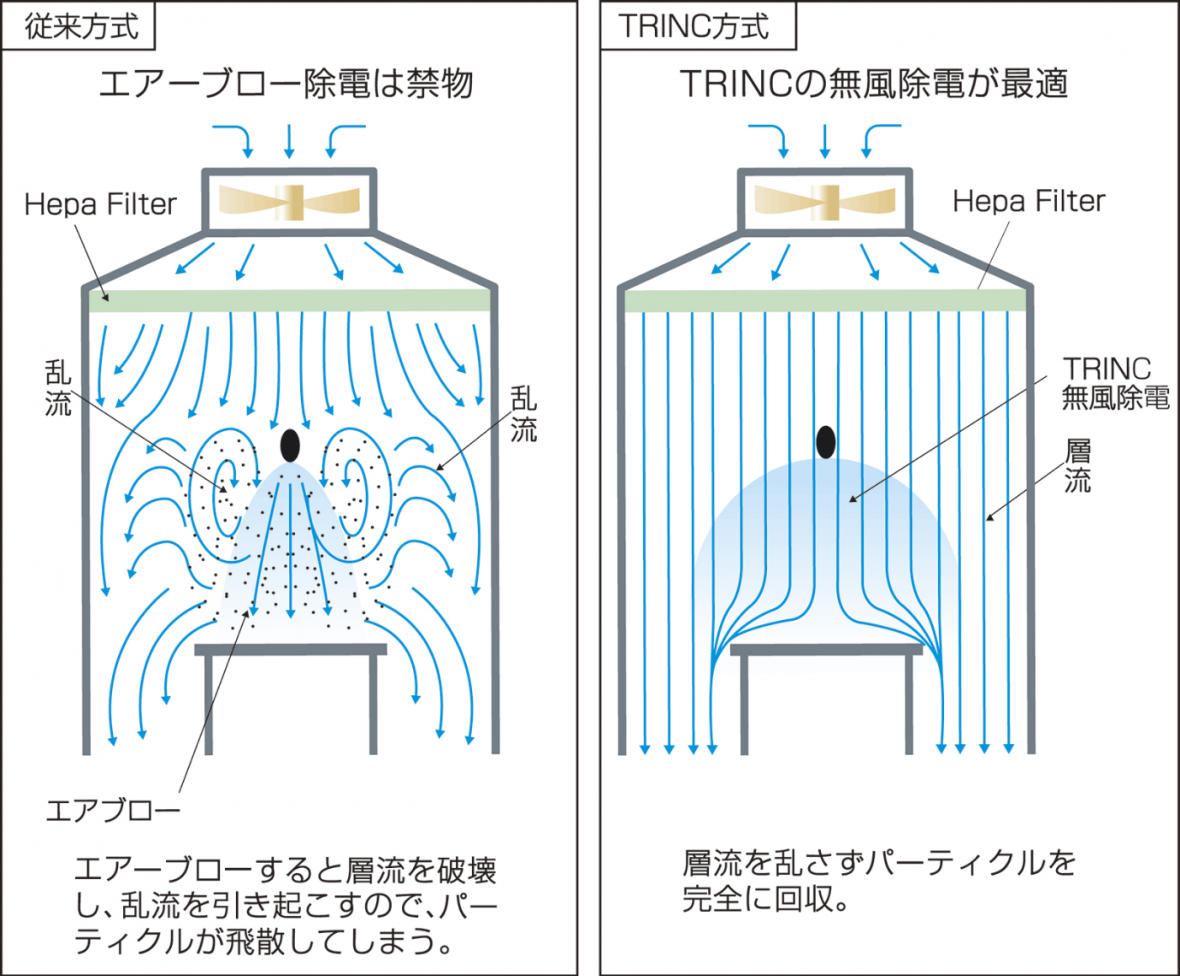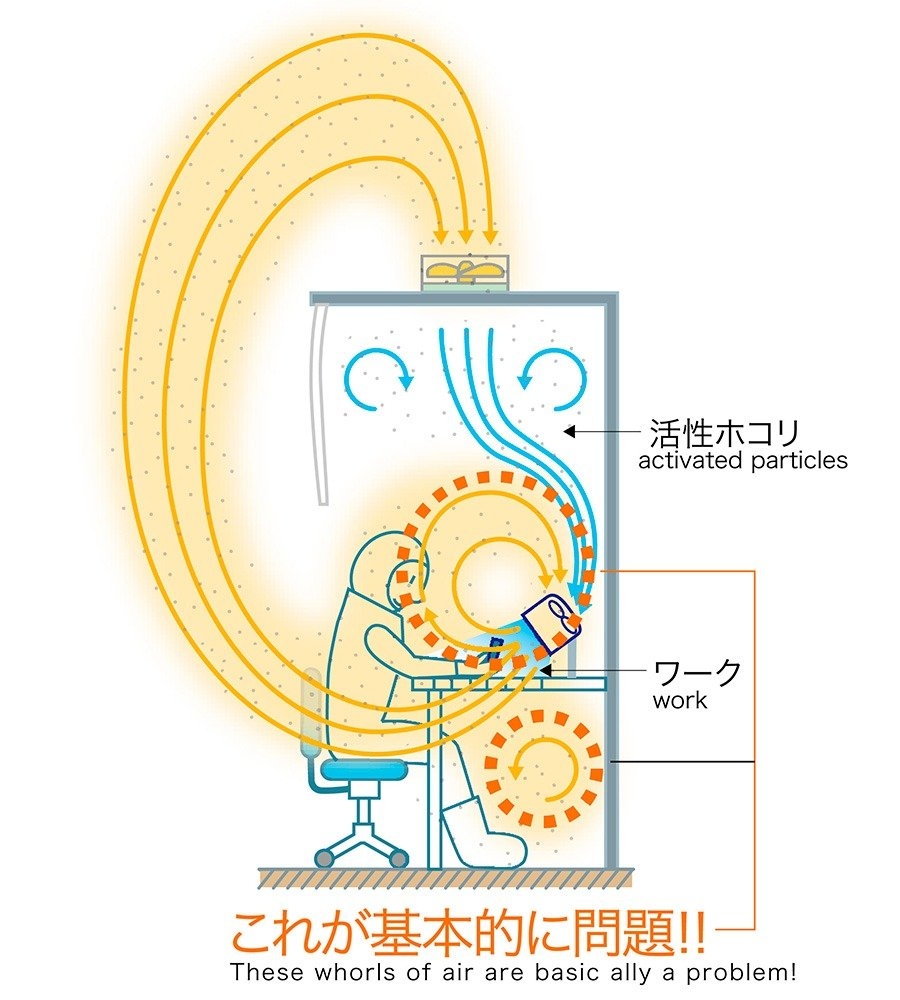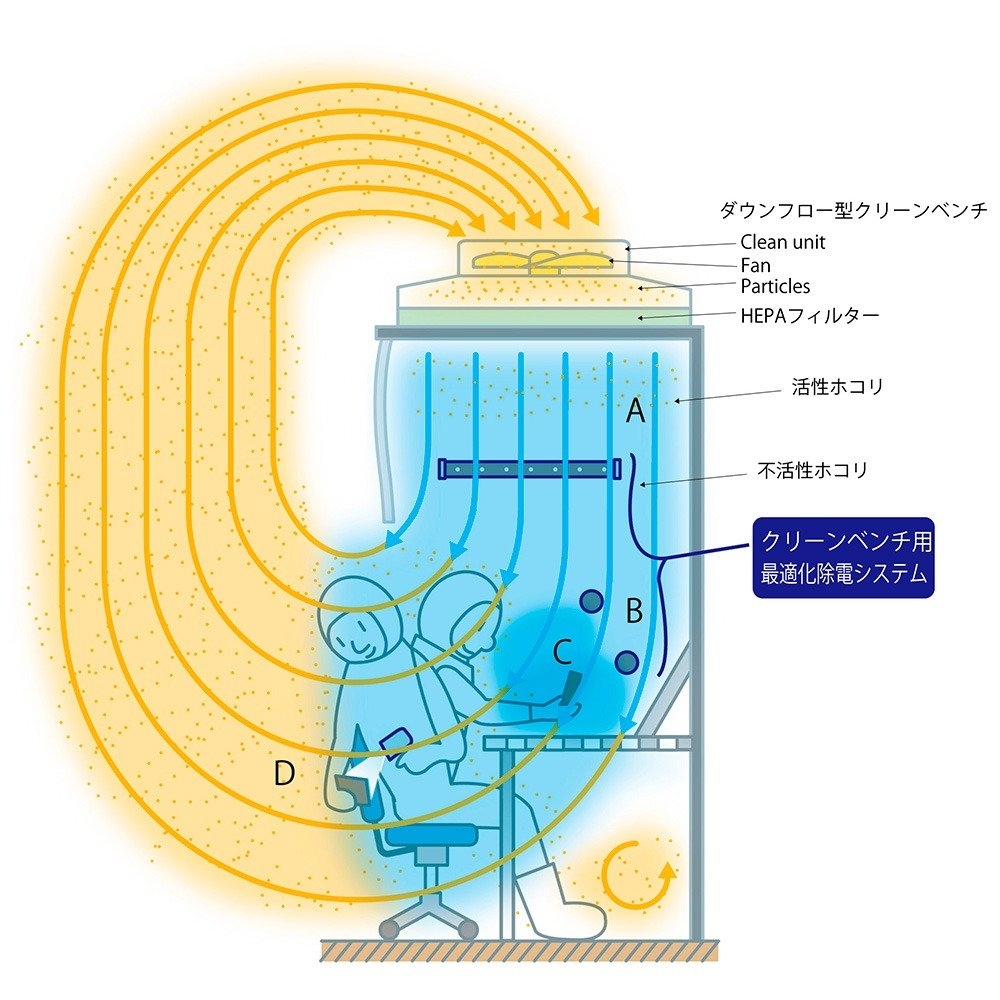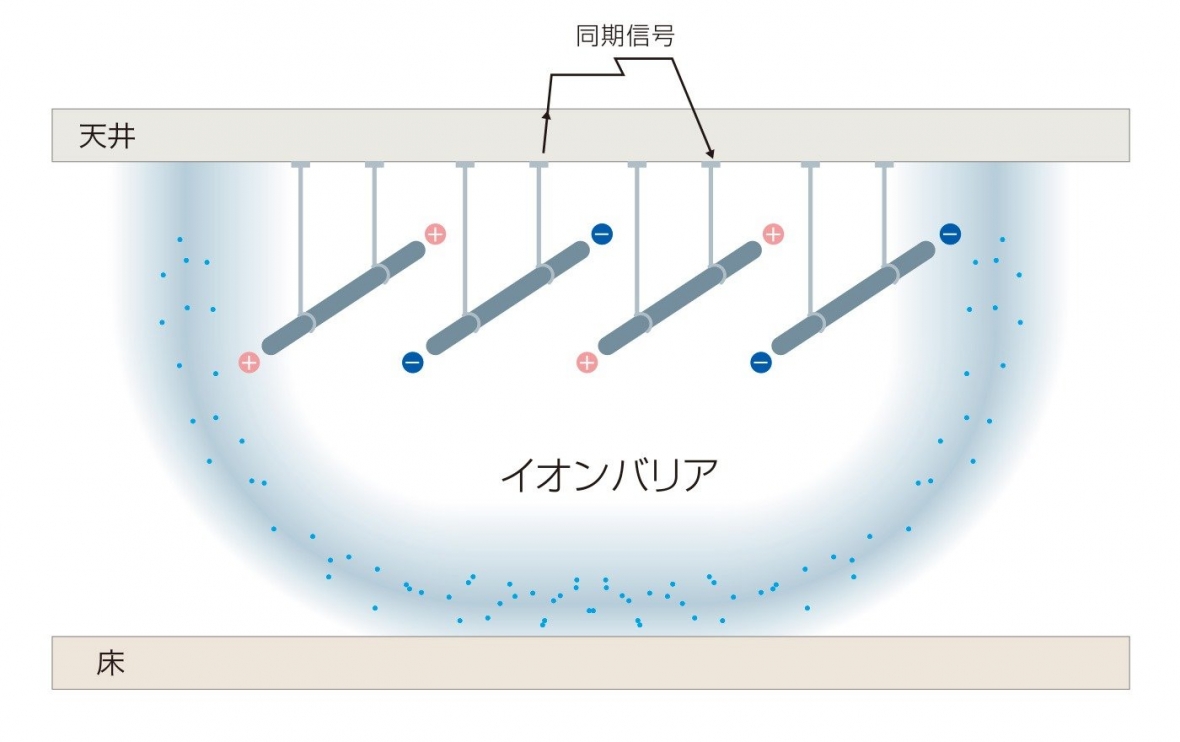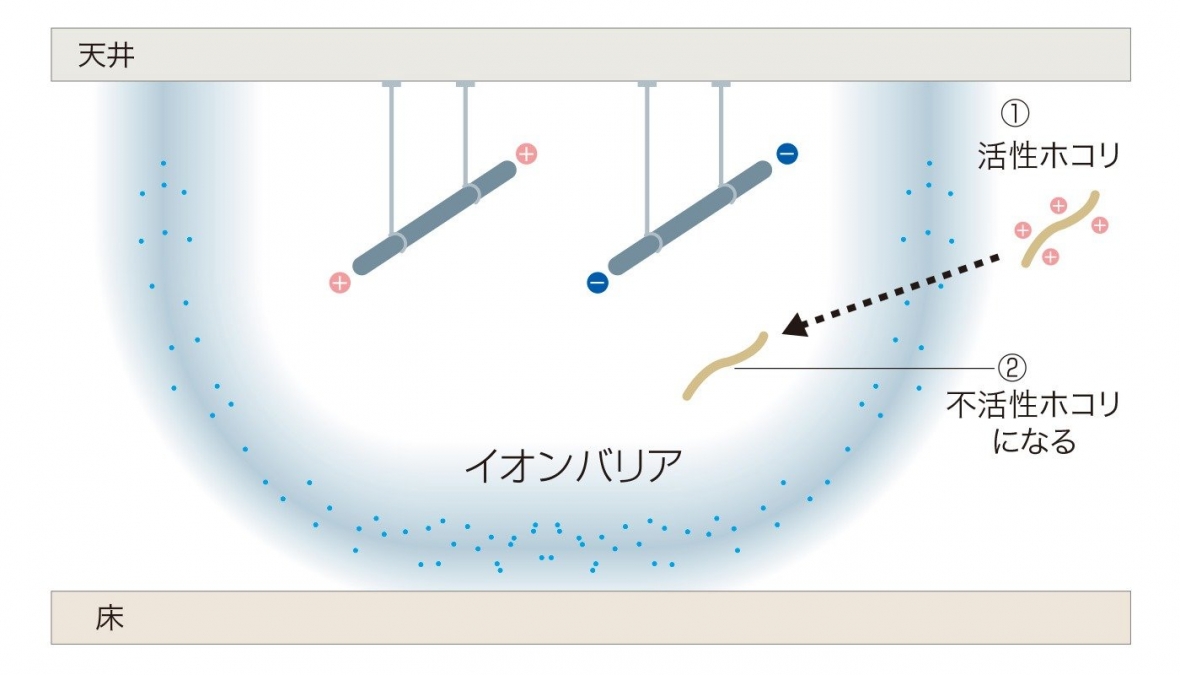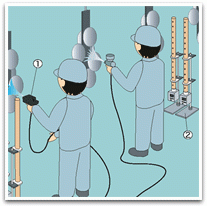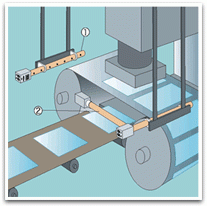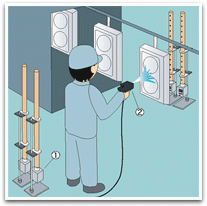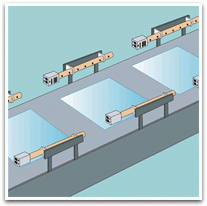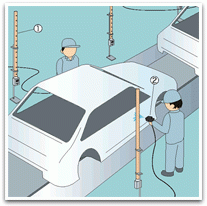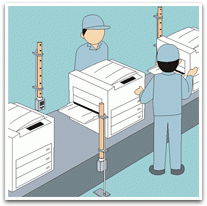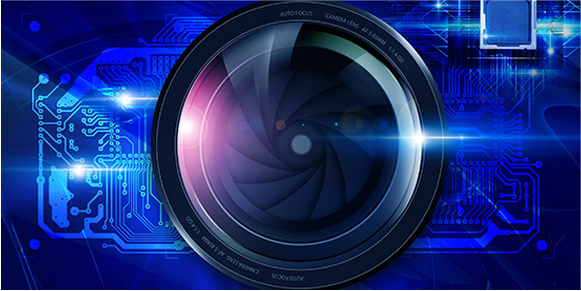TRINC for Anti-static and Anti-foreign objects.
"zero" dust revolution
TRINC has focused attention on the fundamental question "Why dust adheres to workpiece" and analyzed its adherence mechanism.
As a result, two typical factors were identified.
- Charged dust floating in the work area adhere to the workpiece.
- The turbulence, which is created by the air blow used to blow ions with conventional ionizers, disrupts the laminar flow (down-flow) in the clean room, causing dust to fly up and adhere to the workpiece.
★TRINC has succeeded in solving these problems by using unique technologies such as "No-Blow Ionizing®" and "Space ionizing®".
★TRINC proposes ways to realize higher productivity by improving the defective rate due to foreign objects adhering, which we have given up on.
What is "No-Blow Ionizing®"?
In the improved DC type adopted for ion generation by TRINC, positive and negative ions are generated from a pair of discharge electrodes.
It is possible to fly ions far away without using air or blowers by utilizing the Coulomb force, which repels ions of the same polarity and attracts ions of different polarity.
Disturbance of laminar flow by blower type ionizer.
In the clean room or clean bench, dust particles are collected using a laminar air flow filtered through a HEPA filter.
When using a blower type ionizer in an area, it disturbs laminar air flow and generates turbulence.
This turbulence scatters the dust and is causing defects by dusty to occur.
TRINC proposes solutions for these problems by using "No-Blow Ionizing®" technology.
Improvement example with "No-Blow Ionizing®" (Example of a proposal for a down-flow type clean bench)
Since a blower-type ionizer is used in a down-blow type clean bench, turbulent flow is generated and the laminar flow is disturbed, causing dust to re-adhere to the workpiece.
A. Dust is deactivated by using "TRINC's Phased Array Ionizer".
B. Ionizing the workpiece uses a non-airflow bar type ionizer to avoid disturbing the laminar air flow.
C. Workpiece is lifted off the desk.
D. Dust on the workpiece is removed outside the clean bench by using a gun type.
What is "Space ionizing®"?
It is a technology that radiates ions into a space to ionize the entire large space.
→ 1. remove static electricity of dust floating in a large space 2. remove static electricity in a large space
→ 1. Reduce defects by dusty significantly 2. Reduce problems caused by static electricity
→ lead to higher productivity for customers.
"Space ionizing®" principle image
Synchronization control is performed so that ions emitted from adjacent ion generators always have opposite polarities.
The ions are spread evenly throughout the space by using the principle of repulsion and attraction between ions.
It is possible to create an ion barrier in a large space by combining many ion generators based on this principle.
→ Realization of wall-less clean room
Remove floating dust
There are two types of dust.
1. active dust (adherent dust with static electricity)
2. inactive dust (non-adherent dust with no static electricity)
Once the dust adheres to the workpiece, it is difficult to remove. Therefore, the most important point is to remove the static electricity from the dust itself before it adheres to the workpiece, that is, while it is floating in the air.
Introduction case (customer feedback)
[Plastic Parts Painting] Defects were reduced by 52%.
This factory is a simple painting factory without an air filtration filter, and coating is done in an extremely normal environment. The factory had been using "GUN TRINC" to remove dust before the painting process, but they were suffering from problems with defective products. In order to solve this problem, the company introduced "TRINC's Phased Array Ionizer" that wraps around the painting operator and the pre-process dusting operator. The work area was converted into a wall-less clean room, and they have been able to remove dust and paint in the room. As a result, dust-related defects decreased by 52%. It was so effective that the person in charge of the completion inspection in the final process of the line asked, "Suddenly the number of defects has decreased, what did you do?"
[Polarizing Plate Manufacturing Plant] Defect reduced by 72%
At the production plant for LCD Polarizing Plates, the blanking process produces punching debris, which adheres to the product and causes many defects. Since the products and debris are all plastic, static electricity is generated intensely and no useful countermeasures had been found. The plant introduced "Bar TRINC" in the punching process and "Phased Array Ionizer" in the entire blanking process. The debris adherence was drastically reduced, and dust-related defects were reduced by 72%.
[Gas Stove Marker's Painting Plant] Defects were reduced by 75%
In the plant where they paint gas stove chassis, they set up "Phased Array Ionizer" just before putting them into the painting booth. A roomless clean room is created and dust is removed in this room by using "GUN TRINC". As a result, dust-related defects have been reduced by 75%. Because of its very pronounced effect, they expanded the system to all their plants and also completed the installation in their affiliated companies. Previously, they had spent a long time trying to improve defects by using conventional ionizers, but they were confused since they could not get a clear result, so they suspected at first about Improved figures from unexpected effects after the introduction of "Phased Array Ionizer".
[Flat Panel Display (FPD) Factory] Dust-related defects reduces by 75%
Dust adheres to glass substrates during the process of receiving them in the factory, unpacking them, and transferring them to the manufacturing line. Dust also adhered during the process from the manufacturing facility to the following manufacturing facility, causing the yield to below. Of course, the workspace is covered with transparent acrylic so that it is a closed cavity to prevent dust from entering from the outside, but dust still adheres. "Phased Array Ionizer" was installed in the entire cavity. By ionizing the glass substrates and inactivating dust particles, dust-related defects were reduced by 75% from the next day, enabling smooth production.
[Automobile painting plant] Defects reduced by 67%
"Phased Array Ionizer" and "GUN TRINC" were introduced to the pre-paint dusting process at an automobile painting plant, and succeeded in reducing dust-related defects by 67%. The painting defects were caused because dust from the workers' clothes had static electricity and was absorbed on the sheet metal body. "Phased Array Ionizer" was introduced to this work process.
The entire worker and their clothes are ionized, and the dust scattered from the clothes is also made into ionized inactive dust, which removes its adsorption to the car body, thereby eliminating the cause of defects. In the dusting process, "GUN TRINC" are used in combination in the "wall-less clean room" by "Phased Array Ionizer" to prevent scattered dust from reattaching.
[Copier manufacturer] Dust-related complaints reduced by 100%
In an assembly line for medical copiers, a market complaint arose because dust adhered to the shipped products.
When the entire assembly line was converted into a roomless clean room by introducing "TRINC’s Phased Array Ionizer", dust did not adhere to the copiers and the number of dust-related complaints dropped to zero. Thanks to the successful ionization of the copiers and workers, as well as the inactivation of airborne dust, the dust adhesion has become extremely low, and the few remaining dust can be easily removed by ionizing blow.
In this "Phased Array Ionizer", even after dust removing by ionizing blow, dust does not wrap around and reattach to the workpiece, so dust-related complaints have been completely eliminated.
Features of TRINC
- “No-Blow Ionizing®” and ”Phased Array Ionizing®” are TRINC's original technologies and one and only products. Based on these two unique base technologies, TRINC is able to provide the most effective solutions to customers' problems, especially defects by dust and foreign object.
- Other major manufacturers have entered the field of ionizers as one of their many product groups, so they can only handle products that can be mass-produced to some extent. TRINC is a specialized manufacturer for ionizers and has advantages in terms of technology and ability to respond (high-mix low-volume production, customization).

